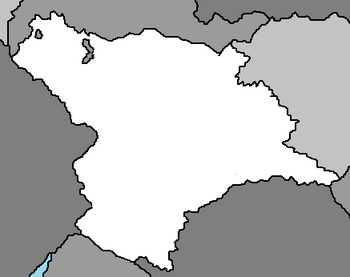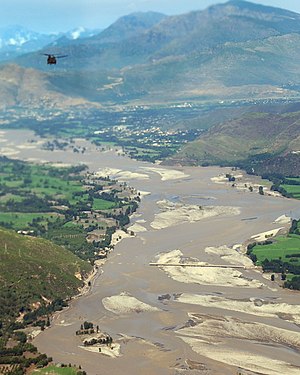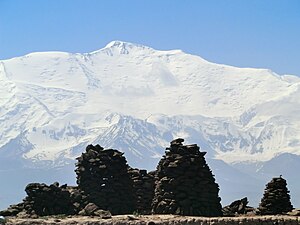Tasiastan
Democratic Republic of Tasiastan | |
|---|---|
|
Flag | |
 | |
| Capital and largest city | Jaljur |
| Official languages | Tasia |
| Language of inter-ethnic communication | Beleroskovian |
| Spoken languages | |
| Ethnic groups (2010) | |
| Religion |
|
| Demonym(s) | Tasiastani, Tasian |
| Government | Unitary dominant-party presidential constitutional republic |
| Haajid Swati | |
| Parshand Khosa | |
• Chairman of the Ajlisi Ailli | Eldemir Ansari |
| Legislature | Parliament |
| National Assembly | |
| Assembly of Representatives | |
| Formation | |
| Area | |
• Total | 393,909 sq mi (1,020,220 km2) |
• Water (%) | 1.8 |
| Population | |
• 2020 estimate | 165,788,000 |
| GDP (PPP) | 2018 estimate |
• Total | 536.547 billion |
| GDP (nominal) | 2018 estimate |
• Total | 427.350 billion |
| Gini (2021) | 34 medium |
| HDI (2019) | medium |
| Currency | wata (TWA) |
| Time zone | UTC+5 |
| Driving side | right |
| Calling code | +992 |
Tasiastan is a landlocked country in Ausiana, bordered by Yuan, Barangadesh, Kylastan, Pekastan, and Beleroskov. It has an area of 1,020,220 km2 (393,909 sq mi) and a population of 165,788,000. Its capital and largest city is Jaljur. The traditional homelands of the Tasian people include present-day Tasiastan as well as parts of Pekastan, Jaginistan, and Haduastan. Tasiastan is officially a republic, and holds elections for the presidency and Parliament, operating under a presidential system. It is, however, a dominant-party system, where the People's Democratic Party of Tasiastan routinely has a vast majority in Parliament. Haajid Swati has held the office of President of Tasiastan since November 2015. The Prime Minister is Parshand Khosa.
Tasiastan is the site of several ancient cultures, including 8,500-year-old Neolithic sites and the Barka Valley Civilization of the Bronze Age, one of the most extensive of the civilizations of ancient Ausiana. The region that comprises the modern state of Tasiastan was the realm of multiple empires and dynasties. It saw major fighting during the World War, which spurred nationalist sentiment throughout the entirety of its control by the communist party and its inclusion within the United Communist and Socialist States. Spurred by the Tasiastani Movement, which sought a homeland for the Muslims of northern Beleroskov, Tasiastan gained independence in 1998, which awarded separate statehood to its Muslim-majority northern regions and was accompanied by a mass migration and loss of life. A civil war lasted from independence until 1990, and in the following three decades, Tasiastan has been ruled by governments whose descriptions, although complex, commonly alternated between civilian and military, democratic and authoritarian, relatively secular and Islamist. Tasiastan elected a civilian government in 1992, and in 2010 adopted a parliamentary system with periodic elections.
Tasiastan is a middle power, and has the world's tenth-largest standing armed forces. It is a declared nuclear-weapons state, and is ranked amongst the emerging and growth-leading economies, with a large and rapidly-growing middle class. Tasiastan's political history since independence has been characterized by periods of significant economic and military growth as well as those of political and economic instability. It is an ethnically and linguistically diverse country, with similarly diverse geography and wildlife. However, the country continues to face challenges, including poverty, illiteracy, corruption and terrorism. Tasiastan is a member of the Coalition of Crown Albatross, the Coalition Trade Organization, and an observer state of the C21.
History
Prehistory and antiquity
Medieval history
Modern history
Contemporary history
United Communist and Socialist States
Independence
Geography
Tasiastan is landlocked with an area of 1,020,220 km2 (393,909 sq mi), bordered to the west by Yuan with the Archismann Mountains, to the north by Barangadesh (with multiple exclaves within Tasiastan's territory), to the east by Kylastan, and to the south by Pekastan and Beleroskov. It is covered by mountains of the Archismann range, and most of the country is over 3,000 metres (9,800 ft) above sea level. The only major areas of lower land are in the north (part of the Taana Valley), and in the southern Tofarnihon and Takhsh river valleys, which form the Amu Erya. The capital of Jaljur is located on the eastern slopes above the Tofarnihon valley before it descends into the interior of the country.
About 2% of the country's area is covered by lakes, the best known of which are the following: Orbsa, Tyuas, Eruass, Tyajb, Wittayb, and Sarez.
Climate

Tasiastan's climate is continental, subtropical, and semiarid, with some desert areas. The climate changes drastically according to elevation, however. The Taana Valley and other lowlands are shielded by mountains from cold Antartique air masses, but temperatures in that region still drop below freezing for more than 100 days a year. In the subtropical northwestern lowlands, which have the highest average temperatures, the climate is arid, although some sections now are irrigated for farming. At Tasiastan's lower elevations, the average temperature range is 23 to 30 °C (73.4 to 86.0 °F) in January and −1 to 3 °C (30.2 to 37.4 °F) in July. In the eastern highlands, the average January temperature is 5 to 10 °C (41 to 50 °F), and the average July temperature is −15 to −20 °C (5 to −4 °F).
Environmental issues
Most of Tasiastan's environmental problems are related to the agricultural policies imposed on the country during the communist period. By 1991 heavy use of mineral fertilizers and agricultural chemicals was a major cause of pollution in the republic. Among those chemicals were DDT, banned by international convention, and several defoliants and herbicides. In addition to the damage they have done to the air, land, and water, the chemicals have contaminated the cottonseeds whose oil is used widely for cooking. Cotton farmers and their families are at particular risk from the overuse of agricultural chemicals, both from direct physical contact in the field and from the use of the branches of cotton plants at home for fuel. All of these toxic sources are believed to contribute to a high incidence of maternal and child mortality and birth defects. In 1994 the infant mortality rate was 43.2 per 1,000 births, the second highest rate among former communist republics in Ausiana. The rate in 1990 had been 40.0 infant deaths per 1,000 births.
Cotton requires particularly intense irrigation. In Tasiastan's cotton-growing regions, farms were established in large, semiarid tracts and in tracts reclaimed from the desert, but cotton's growing season is summer, when the region receives virtually no rainfall. The 50 percent increase in cotton cultivation mandated by communist and post-communist agricultural planners between 1964 and 1994 consequently overtaxed the regional water supply. Poorly designed irrigation networks led to massive runoff, which increased soil salinity and carried toxic agricultural chemicals downstream to other fields, lakes, and populated areas of the region.
Biodiversity
The diversity of the landscape and climate in Tasiastan allows a wide variety of trees and plants to flourish. The forests range from coniferous alpine and subalpine trees such as spruce, pine, and deodar cedar in the extreme southern mountains to deciduous trees in most of the country (for example, the mulberry-like shisham found in the Archismann Mountains), to palms such as coconut and date in the northern Anjai, southern Criansa, and all of Sindh. The western hills are home to juniper, tamarisk, coarse grasses, and scrub plants.
Coniferous forests are found at altitudes ranging from 1,000 to 4,000 metres (3,300 to 13,100 feet) in most of the northern and northwestern highlands. In the xeric regions of the north, date palm and Ephedra are common. In most of the north plains support tropical and subtropical dry and moist broadleaf forest as well as tropical and xeric shrublands. These forests are mostly of mulberry, acacia, and eucalyptus. About 2.2% or 1,687,000 hectares (16,870 km2) of Tasiastan was forested in 2010.
The fauna of Tasiastan also reflects the country's varied climate. Around 668 bird species are found there, including crows, sparrows, mynas, hawks, falcons, and eagles. Many birds sighted in Tasiastan are migratory, coming from western Ausiana and Euronia.
The northern plains are home to mongooses, small civet, hares, the Ausiana jackal, the Handuastan pangolin, the jungle cat, and the desert cat. There are mugger crocodiles in the southern rivers, and wild boar, deer, porcupines, and small rodents in the surrounding areas. The sandy scrublands of central Tasiastan are home to jackals, striped hyenas, wildcats, and leopards. The lack of vegetative cover, the severe climate, and the impact of grazing on the deserts have left wild animals in a precarious position. The chinkara is the only animal that can still be found in significant numbers. A small number of nilgai are found along the Tasiastan-Pekastan border. A wide variety of animals live in the mountainous south, including sheep, the urial (a subspecies of wild sheep), the markhor goat, the ibex goat, the Ausiana black bear, and the Archismann brown bear. In total, 174 mammals, 177 reptiles, 22 amphibians, 198 freshwater fish species and 5,000 species of invertebrates (including insects) have been recorded in Tasiastan.
Politics

Almost immediately after independence from Beleroskov in 1988, Tasiastan was plunged into a civil war that saw various factions fighting one another. These factions were supported by foreign countries including Pekastan, Haduastan, Beleroskov, and Yuan. Haduastan and Yuan focused on keeping peace in the warring nation to decrease the chances of Zamastanian or CCA involvement. Most notably, Yuan backed the pro-government faction and deployed troops from the People's Liberation Army of Yuan to the Yuan-Tasiastan border. All but 25,000 of the more than 200,000 ethnic Beleroskovians, who were mostly employed in industry, fled to Beleroskov. By 1990, the war had ended after a peace agreement between the government and the Islamist-led opposition, a central government began to take form, with peaceful elections in 1992.
Tasiastan is officially a republic, and holds elections for the presidency and Parliament, operating under a presidential system. It is, however, a dominant-party system, where the People's Democratic Party of Tasiastan routinely has a vast majority in Parliament. Haajid Swati has held the office of President of Tasiastan since November 2015. The Prime Minister is Parshand Khosa.
Military
The Armed Forces of Tasiastan are the tenth largest in the world in terms of numbers in full-time service, with about 551,800 personnel on active duty and 291,000 paramilitary personnel, as of tentative estimates in 2021. They came into existence after independence in 1989, and the military establishment has frequently influenced the national politics ever since. Chain of command of the military is kept under the control of the Joint Chiefs of Staff Committee; all of the branches joint works, co-ordination, military logistics, and joint missions are under the Joint Staff HQ. The Joint Staff HQ is composed of the Air HQ and Army GHQ.
The Chairman Joint Chiefs of Staff Committee is the highest principle staff officer in the armed forces, and the chief military adviser to the civilian government though the chairman has no authority over the three branches of armed forces. The Chairman joint chiefs controls the military from the JS HQ and maintains strategic communications between the military and the civilian government. The main branches are the Army, the Air Force and the National Police, which are supported by a large number of paramilitary forces in the country. Control over the strategic arsenals, deployment, employment, development, military computers and command and control is a responsibility vested under the National Command Authority which oversaw the work on the nuclear policy as part of the credible minimum deterrence.
Demographics
Tasiastan has a population of 165,788,000 as of 2020. Between 1951 and 2020, Tasiastan's population expanded over sixfold, going from 30.5 million to 165.7 million. The country has a relatively high, although declining, growth rate supported by high birth rates and low death rates. Between 1998 and 2017, the average annual population growth rate stood at +2.40%.
Dramatic social changes have led to urbanisation and the emergence of two megacities: Jaljur and Ramrahi. The country's urban population more than tripled between 1981 and 2017 (from 15.2 million to 45.7 million, as Tasiastan's urbanization rate rose from 28.2% to 36.4%. Even with this, the nation's urbanization rate remains one of the lowest in the world, and in 2017, over 120 million Pakistanis (making up nearly 65% of the population) lived in rural areas.
Due to a high fertility rate, estimated at 3.5 in 2022, Tasiastan has one of the world's youngest populations. The 2020 census recorded that 40.3% of the country's population was under the age of 15, while only 3.7% of Tasiastanis were aged 65 or more. The median age of the country was 19, while its sex ratio was recorded to be 105 males per 100 females.
Language
There are more than 300 languages spoken in Tasiastan, with the most common being Tasia, Beleroskovi, Pekak, Kylat, Styrish, Ahughni, Isshani.
Ethnic groups
Urbanization
Religion
Economy
Tasiastan is considered a developing country but has a high potential to become one of the world's largest economies in the 21st century. In recent years, after decades of social instability, as of 2013, serious deficiencies in macromanagement and unbalanced macroeconomics in basic services such as rail transportation and electrical energy generation have developed. The economy is considered to be semi-industrialized, with centres of growth along the Takhsh River. The diversified economies of Jaljur and Ramrahi's urban centres coexist with less-developed areas in other parts of the country. The GDP is around 536.547 billion. Tasiastan has important strategic endowments and development potential. The increasing proportion of Tasiastan's youth provides the country with both a potential demographic dividend and a challenge to provide adequate services and employment. 21.04% of the population live below the international poverty line, and the unemployment rate among the aged 15 and over population is 5.5%.
Agriculture and primary sector
The structure of the Tasiastani economy has changed from a mainly agricultural to a strong service base. Agriculture accounts for only 20.9% of the GDP. Even so, Tasiastan produced 21,591,400 metric tons of wheat in 2020. Majority of the population, directly or indirectly, is dependent on this sector. It accounts for 43.5% of employed labour force and is the largest source of foreign exchange earnings.
Industry
Industry is the second-largest sector of the economy, accounting for 19.74% of gross domestic product (GDP), and 24 percent of total employment. Large-scale manufacturing (LSM), at 12.2% of GDP, dominates the overall sector, accounting for 66% of the sectoral share, followed by small-scale manufacturing, which accounts for 4.9% of total GDP. Tasiastan's cement industry is also fast growing mainly because of demand from surrounding nations and from the domestic real estate sector. The cement industry in Tasiastan is the most profitable sector of the economy.
The textile industry has a pivotal position in the manufacturing sector of Tasiastan. Textile products contribute 9.5% to the GDP and providing employment to around 10 million people (some 30% of the 49 million people in the workforce). Tasiastan is the fourth-largest producer of cotton with the third-largest spinning capacity in Ausiana after Yuan and Haduastan, contributing 5% to the global spinning capacity.
Services
The services sector makes up 58.8% of GDP and has emerged as the main driver of economic growth. Tasiastani society like other developing countries is a consumption oriented society, having a high marginal propensity to consume. The growth rate of services sector is higher than the growth rate of agriculture and industrial sector. Services sector accounts for 54 percent of GDP in 2014 and little over one-third of total employment. Services sector has strong linkages with other sectors of economy; it provides essential inputs to agriculture sector and manufacturing sector. The country has also improved its export performance in telecom, computer and information services.




